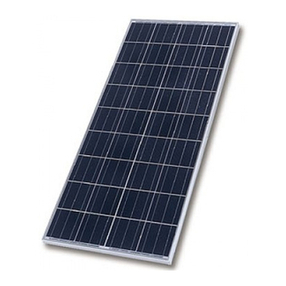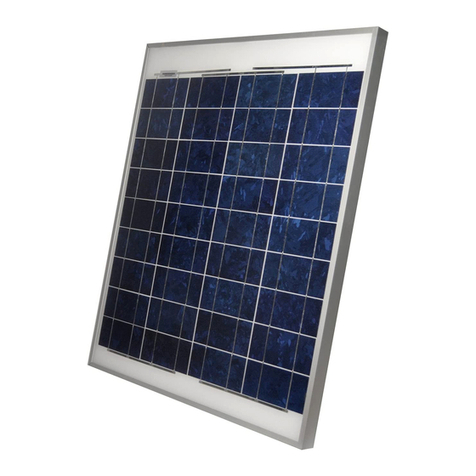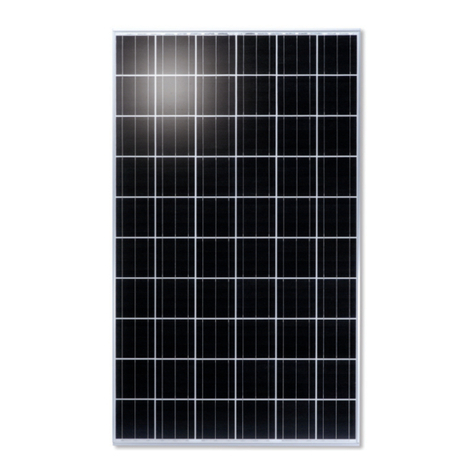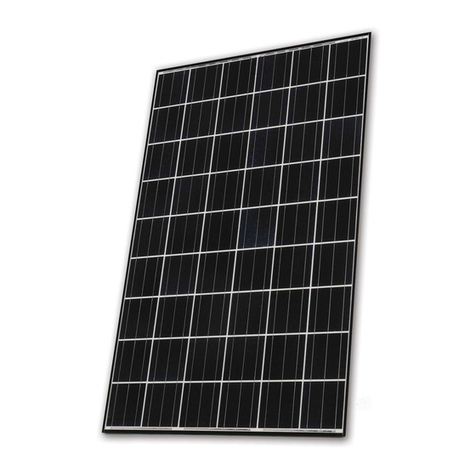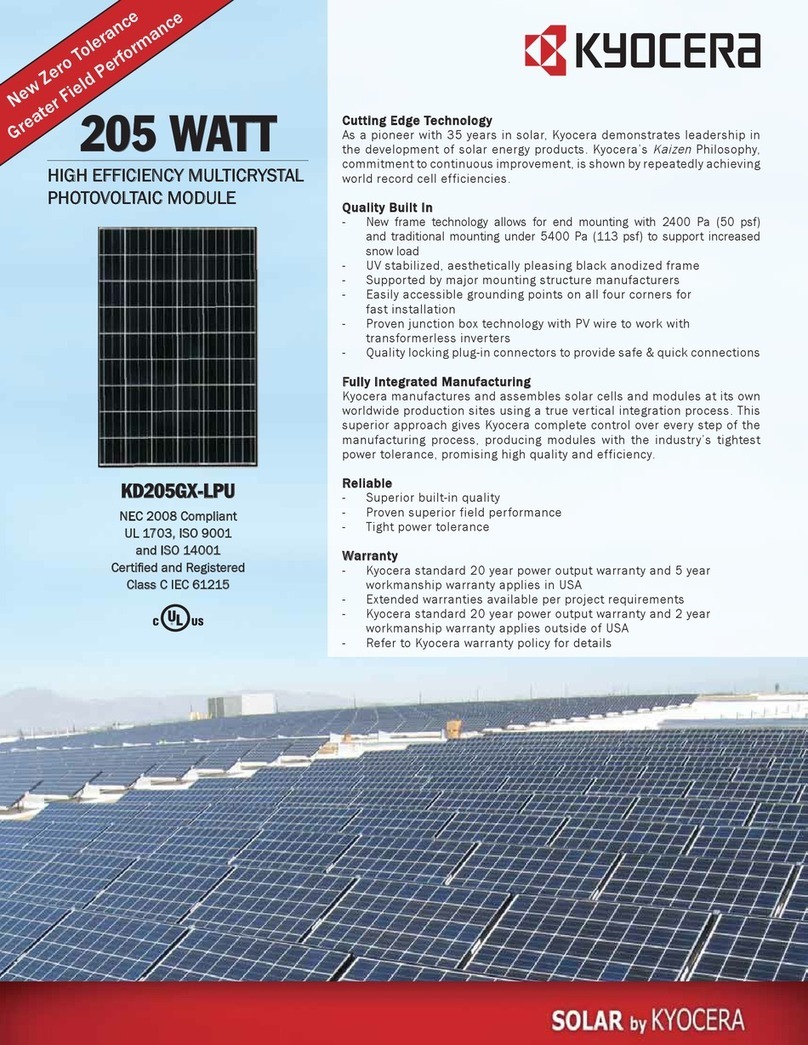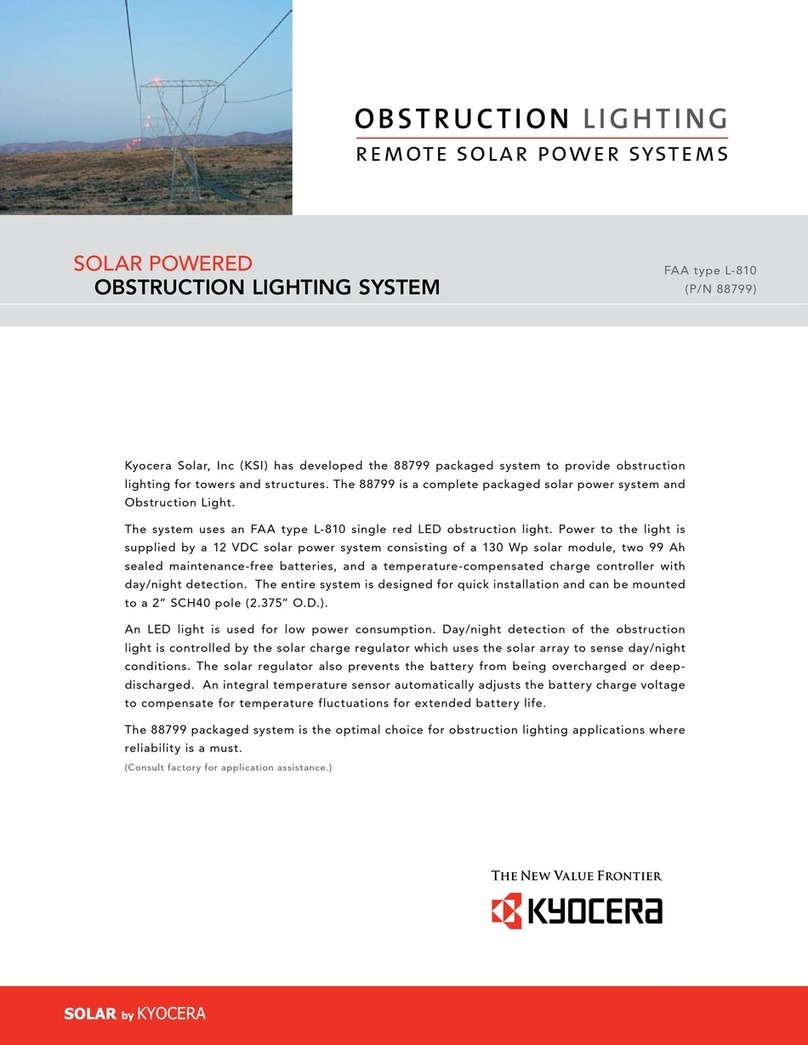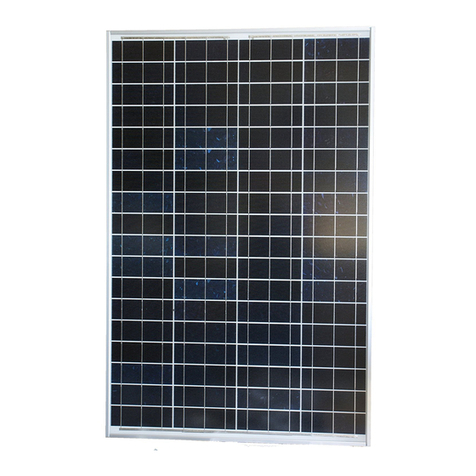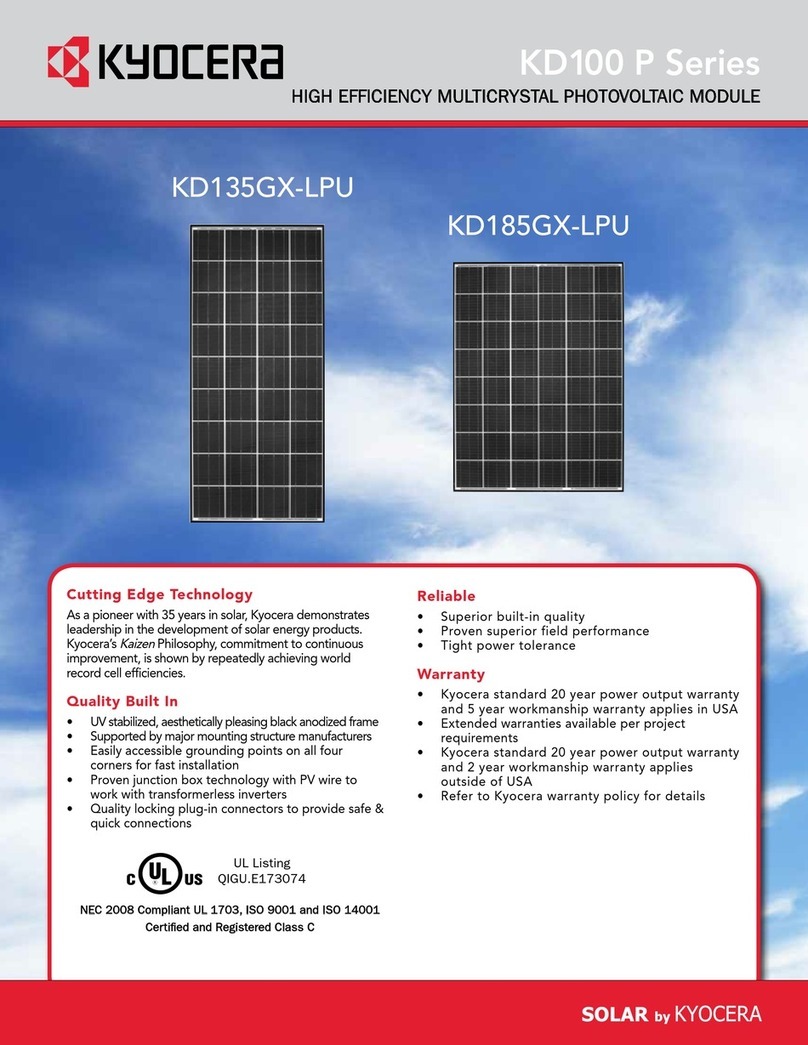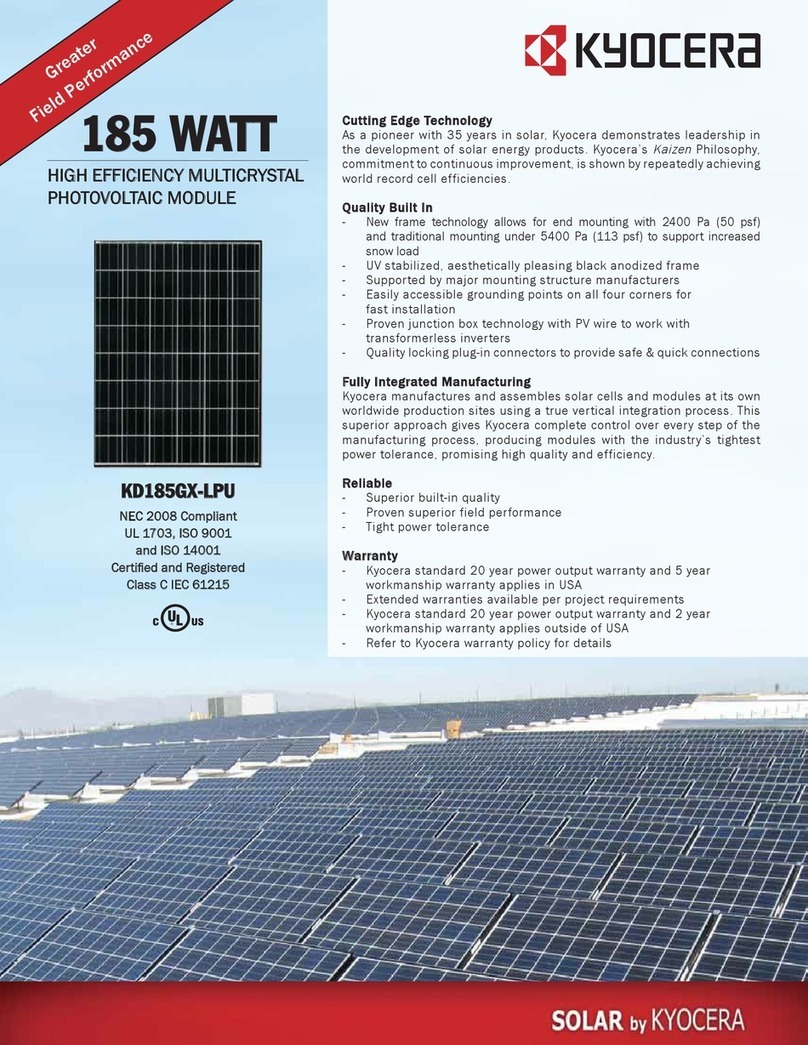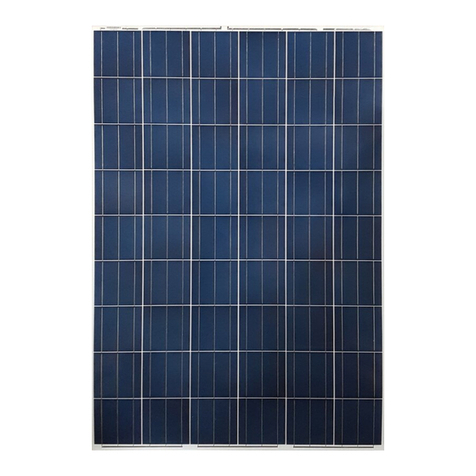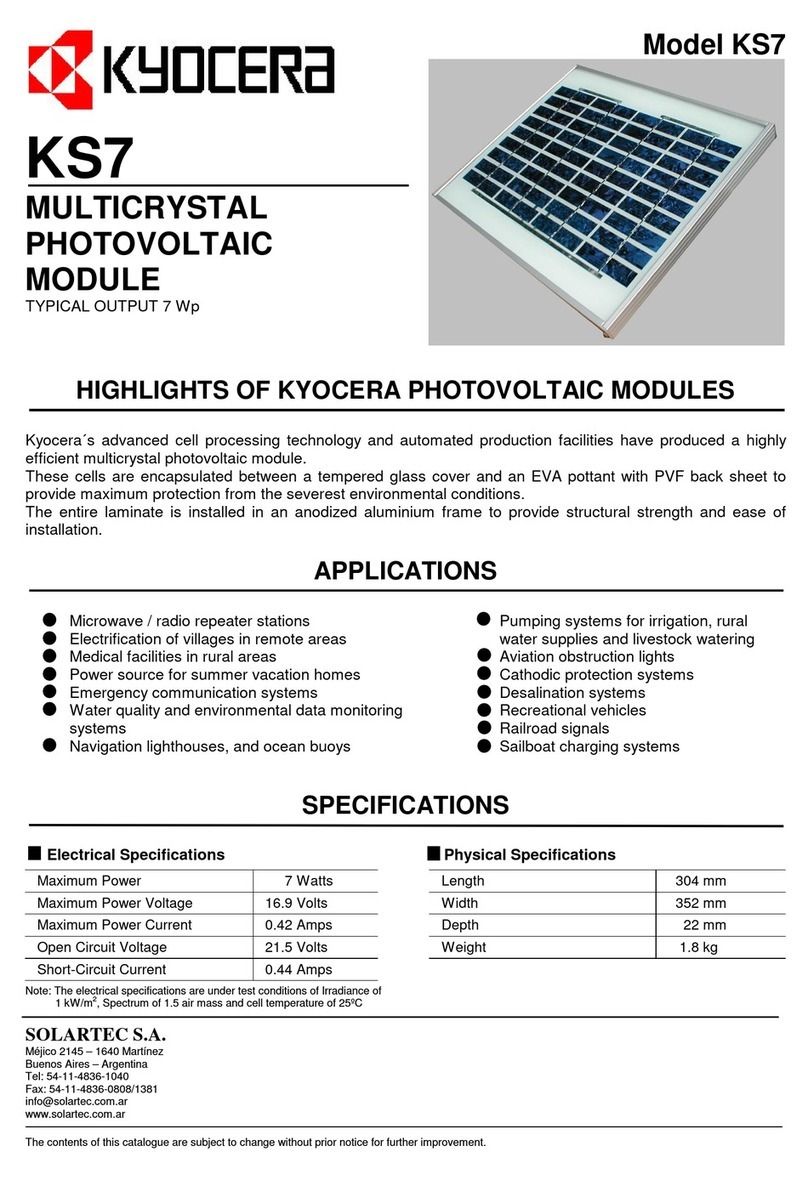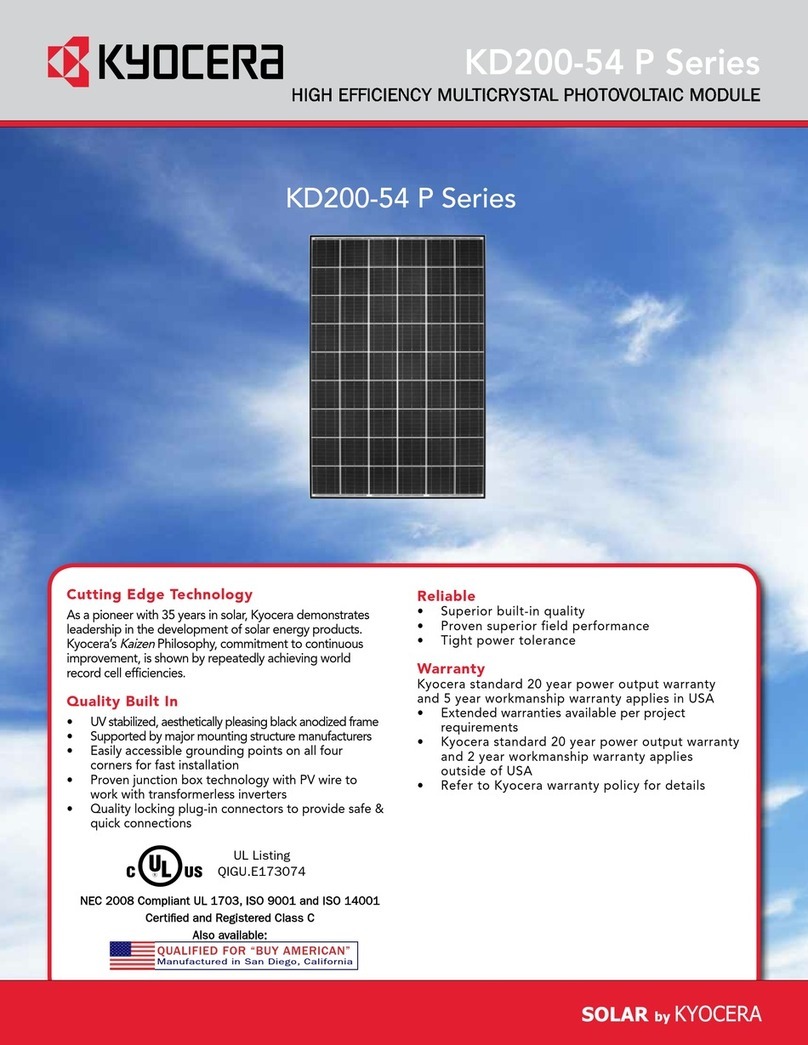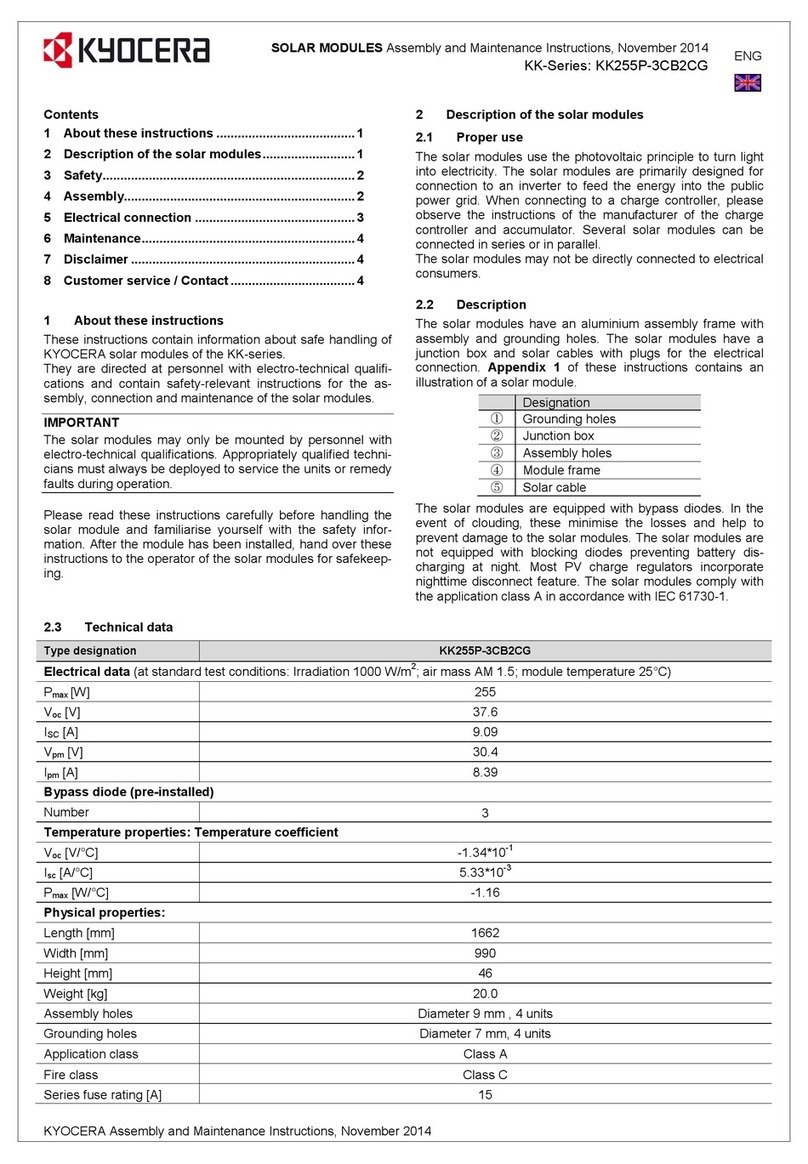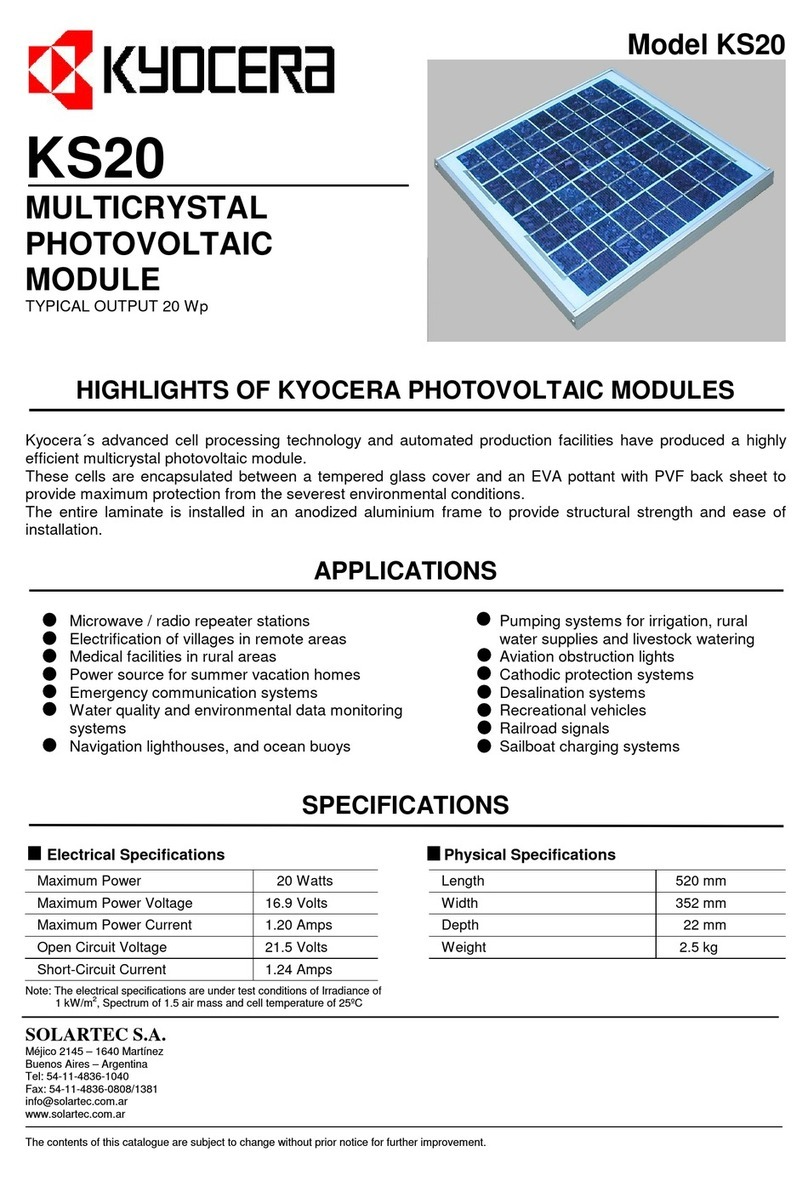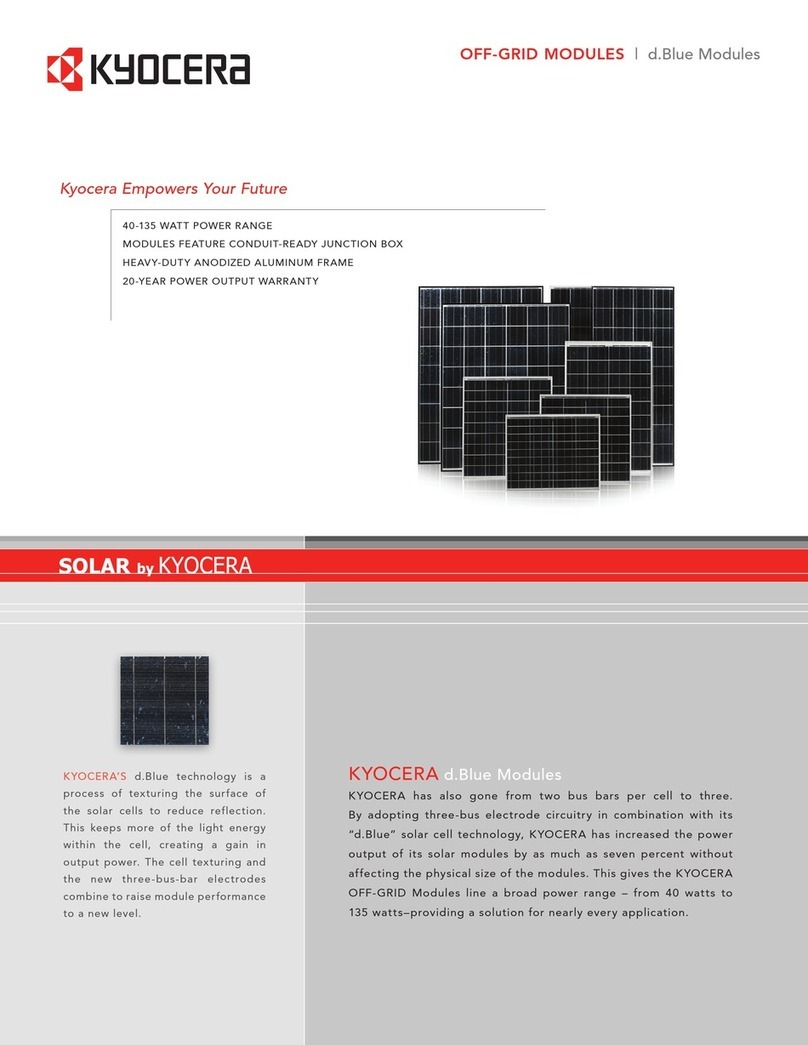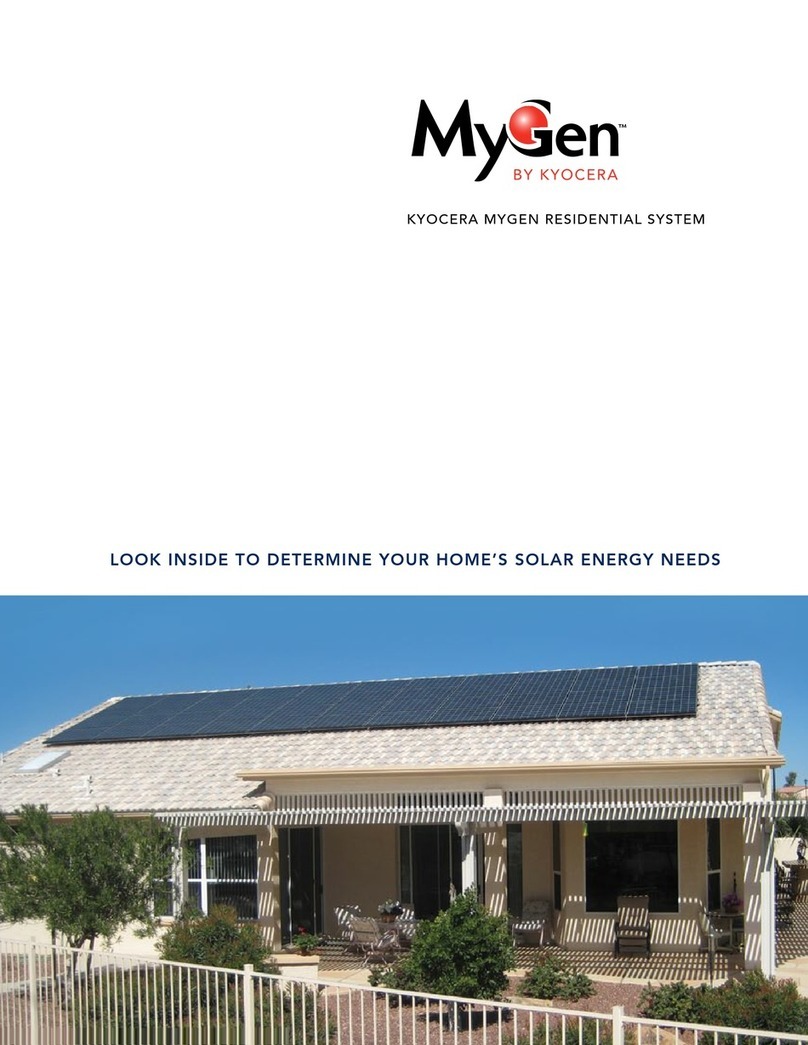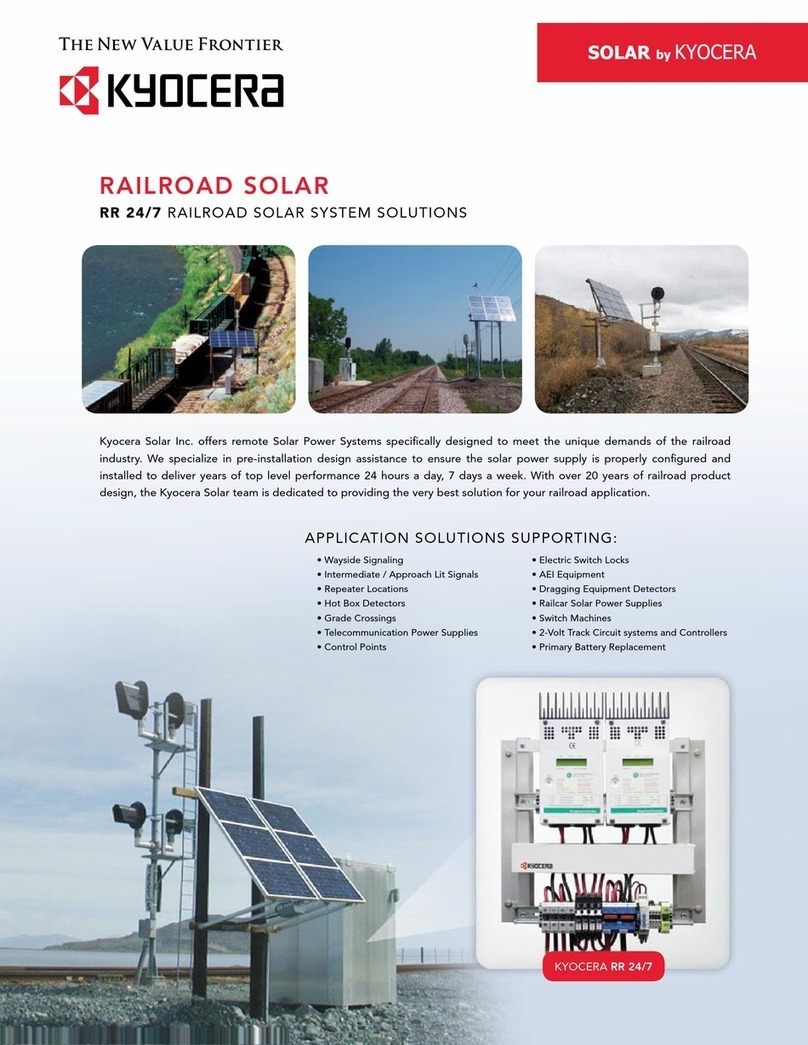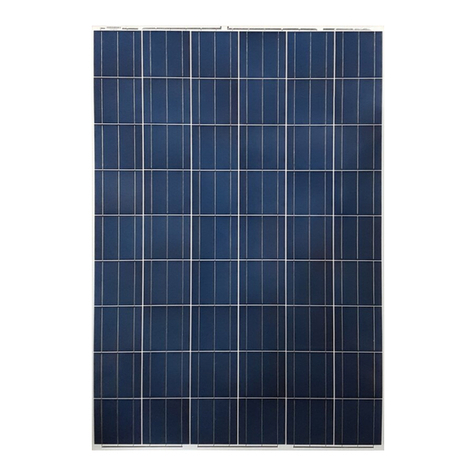
KYOCERA Assembly and Maintenance Instructions, March 2010
4.4 Mounting the solar module
Please observe the following during assembly:
•A clearance of at least 15 mm needs to be kept be-
tween the module frame and the attachment surface.
This allows the cool ambient air to circulate below the
solar module. This is necessary for optimum perform-
ance in all application ranges.
•There should be a clearance of at least 3.2 mm be-
tween the individual module frames to allow heat-
related expansion.
•The solar modules can be installed in either an up-
right or landscape position.
•If high accumulations of snow on the lowest module
row occur on site, the lower part of the frame may be
damaged when slipping snow is piled up there. This
can be avoided by e.g. attaching support parts at the
lowest modules.
•When selecting the material for the support structure,
pay attention to the electrochemical series in order to
avoid galvanic corrosion between different kinds of
metal.
•Fasten modules firmly to a support structure designed
to withstand the local wind and snow loads
4.4.1 Screw attachment
Assembly material
•Stainless steel screws, diameter 8 mm (4 units)
•Nuts with locking teeth (4 units)
NOTE
No holes may be drilled into the module frame.
Procedure
9Please see the drawing in Appendix 1 of these
instructions for the positions of the mounting holes.
9Drill the required assembly holes to the support
structure.
9Tighten the screws with adequate torque (usually
12.5 Nm) to securely attach the solar module to the
supporting frame. As adequate torque figure depends
on selected bolt nuts, follow the manufacturers'
recommended numbers.
4.4.2 Clamps
Assembly material
•Rustproof module clamps (at least 4 units).
•Please observe the information provided by the
manufacturer when selecting the clamps.
NOTE
The module clamps
- must not bend the module frame.
- must not touch the front glass.
- must not cast a shadow on the front glass.
- must not damage the surface of the frame.
- must be at least 40 mm long respectively.
- must overlap the module frame by at least 7 mm.
- must cover the module frame by min. 360 mm² respectively.
Minimum clamp length for each overlap:
Procedure
9Define the positions of the clamps based on the
drawings in Appendix 2.
9Tighten the module clamps to the torque stated by
the clamp manufacturer.
9Fasten modules firmly by clamps designed to with-
stand the local wind and snow loads.
4.4.3 Assembly to insertion system
When mounting the modules to an insertion system, follow
the instructions in the drawings in Appendix 2. Please ob-
serve the information provided by the manufacturer.
5Electrical connection
5.1 Safety information relating to the electrical
connection
5.2 Wiring of the solar modules
NOTE
The maximum system voltage of solar modules connected to
each other may not exceed 1000 VDC. When designing the
system, please note that the module voltage increases when
the temperatures are low. Do not connect the modules in
parallel without max. over current protection.
Under normal conditions, solar modules can supply higher
currents and/or a higher voltage than reported at the stan-
dard test conditions (see chapter 2.3 “Technical Data”).
Therefore, when determining component voltage ratings,
conductor current ratings, fuse sizes, and the size of controls
connected to the output of the solar modules, the stipulated
values of ISC and Voc should be multiplied with a factor of 1.25.
Only interconnect modules of the same type within a system.
The solar modules are equipped ex-works with 4 mm2-solar
cables. The solar cables have Multi-Contact® PV-3-plugs.
These plugs are designed for series wiring only. Always use
special solar cables with a diameter of at least 4 mm² and
Multi-Contact® PV-3-plugs for further series or parallel wiring.
When wiring, proceed as follows:
•Ensure the poles are connected correctly and that the
plugs are connected properly without gaps
•Observe the minimum bending radius of 24.5 mm of
the solar cables that are used.
5.3 Connection of the solar modules
Please observe the information provided by the manufacturer
of the inverter when connecting the solar modules to an
inverter.
overlap [mm] 7 7.5 8 8.5 9 10
minimum
length [mm] 51.5 48 45 42.4 40 40
Only specially trained and qualified personnel
may make the electrical connection.
Hazard!
Potentially fatal risk if live parts are touched.
•Never disconnect or connect electrical con-
tacts when under load.
•Only use dry, insulated tools for the electrical
assembly work.
•Never touch live parts with bare hands.
•Cover the solar module during installation
with opaque foils or materials.
•Do not wear any metal jewellery.
KYOCERA Assembly and Maintenance Instructions, March 2010
5.4 Grounding of the solar modules
To minimise the risk of an electrical shock, the frames of the
solar modules should be grounded.
Assembly material
•stainless steel screw, diameter 8 mm with serrated
washer and nut
•suitable grounding cable
NOTE
Ensure that the anodised layer of the frame is penetrated and
a secure electrical contact is created with the frame.
Procedure
9Please see the drawing in Appendix 1 of these in-
structions for the positions of the grounding holes.
9Screw the grounding cable firmly to one of the
grounding holes using the stainless steel screw and a
min. torque of 8 Nm.
6Maintenance
Only specially trained and qualified personnel
may service the solar system.
KYOCERA solar modules are designed for long-term service
and are almost maintenance-free.
6.1 Safety information relevant for maintenance
6.2 Cleaning the solar module
When the slope is adequate (> 15 degrees), the solar mod-
ules do not need to be cleaned thanks to the self-cleaning
effect of the rain. If heavily soiled, clean with plenty of water,
a mild detergent and a soft cloth/sponge.
6.3 Solar module maintenance
The system should be inspected once a year with regard to
the following:
•Secure hold and no rust on any of the attachments
•Secure connection, cleanliness and that all cable con-
nections are free of corrosion
•Soundness of cables and front glass
7Disclaimer
KYOCERA’s “Limited Warranty for Photovoltaic-Modules”
does not apply if this assembly and maintenance instruction is
not strictly observed. KYOCERA will not assume any liability for
damage arising from improper use, wrong assembly, opera-
tion or maintenance.
8Customer service / Contact
KYOCERA Fineceramics GmbH
Solar Division
Fritz-Mueller-Strasse 27
D-73730 Esslingen / Germany
•for technical questions:
Tel: +49 (0)711-93934-998
Fax: +49 (0)711-93934-861
•for general questions:
Tel: +49 (0)711-93934-999
Fax: +49 (0)711-93934-950
You will find more information and the latest data sheets,
warranty conditions, certificates etc. in the download
section of our website: www.kyocerasolar.eu
Warning!
Risk of falling when working on roofs.
•Use suitable fall protection equipment.
•Observe the accident prevention regulations.
Appendix 1
cGrounding holes
dJunction box
eAssembly holes
fModule frame
gSolar cable
